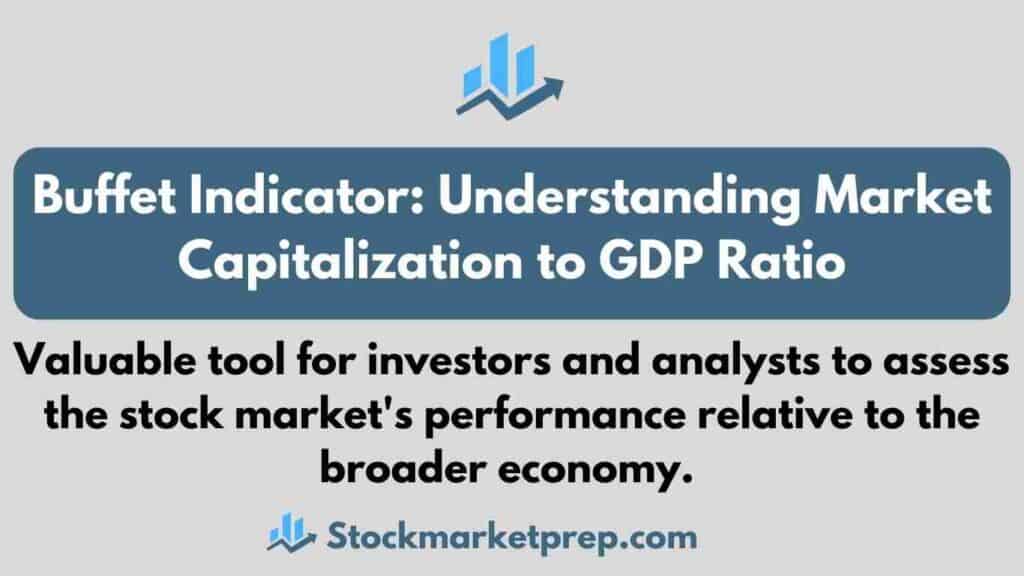
Table of Contents
Toggle1. Introduction
The Market Capitalization to GDP Ratio is an important indicator that helps investors and analysts assess the stock market’s performance relative to the overall economy. It is commonly referred to as the “Buffett Indicator” as it was popularized by Warren Buffett, who considers it to be a useful measure of market valuation.
2. How to Calculate Market Capitalization to GDP Ratio (Buffett Indicator)
Buffett Indicator (Market Capitalization to GDP Ratio) is a valuable tool for investors and analysts to assess the stock market’s performance relative to the broader economy. Here’s how to calculate the Market Capitalization to GDP Ratio:
Step 1: Determine Stock Market Capitalization
To calculate the stock market capitalization, add up the market value of all listed companies’ outstanding shares. Market value is calculated by multiplying the number of outstanding shares by the current market price of each share.
Step 2: Calculate GDP
To calculate the Gross Domestic Product (GDP), add up the total value of all goods and services produced in the country over a specific period, typically a year. This can be done by adding up the value of all goods and services produced, including government spending and net exports.
Step 3: Divide Stock Market Capitalization by GDP
Market cap/GDP = Market Capitalization to GDP Ratio
Once you have determined the stock market capitalization and GDP, divide the former by the latter to get the Market Capitalization to GDP Ratio. The resulting number will give you an idea of how expensive or cheap the stock market is relative to the overall economy.
For example, if the stock market capitalization is $10 trillion and the GDP is $20 trillion, the Market Capitalization to GDP Ratio would be 0.5. This ratio suggests that the market capitalization represents about half of the country’s GDP.
3. What the Stock Market Capitalization-to-GDP Ratio Can Tell You
The ratio can provide valuable insights into the market’s performance relative to the broader economy.
A. Market Valuation Interpretation
The Stock Market Capitalization-to-GDP Ratio is a significant measure because it indicates the overall size and value of the stock market in comparison to the economy. The ratio can also provide insight into the market’s valuation. If the ratio is high, it indicates that the market is overvalued relative to the economy, and investors may want to be cautious about investing at that time. However, if the ratio is low, it suggests that the market is undervalued relative to the economy, and investors may want to consider investing at that time.
B. Historical Performance Analysis
By analyzing the ratio over time, investors can also gain insight into the market’s historical performance. For example, during the dot-com bubble in the late 1990s, the Stock Market Capitalization-to-GDP Ratio reached an all-time high of 1.7. This high ratio indicated that the market was overvalued, and the bubble eventually burst in 2000, causing significant losses for investors.
Another example is the 2008 financial crisis, where the ratio reached 1.2 in the US. This high ratio indicated that the market was overvalued, and the crisis eventually caused a significant market correction.

C. Warren Buffett Sees Opportunity in India’s Low Stock Market Capitalization-to-GDP Ratio
In 2013, India’s Stock Market Capitalization-to-GDP Ratio was around 0.6, which was considered a low ratio. The ratio had been declining for several years, and investors were cautious about investing in the Indian market.
However, Warren Buffett, who popularized the use of the Buffett Indicator, saw the low ratio as an opportunity to invest in the Indian market. In an interview with CNBC that year, Buffett stated that the ratio was “the single best measure of where valuations stand at any given moment.” He went on to say that he believed the Indian market was undervalued and presented a buying opportunity.
Buffett’s comments attracted attention to the Indian market, and investors started to take notice of the low ratio. As a result, the Indian stock market experienced significant growth over the next few years, with the Nifty50 (India’s benchmark stock index) growing by over 70% between 2013 and 2015.
This example demonstrates how a low Stock Market Capitalization-to-GDP Ratio can present a buying opportunity for investors who are willing to take a long-term view. By recognizing the significance of the ratio and its historical relationship with market performance, investors can potentially identify undervalued markets and make profitable investments.
4. Best Range to Invest, Sell, and Book Profit
While there is no one-size-fits-all answer, a ratio between 0.5 and 0.75 is often considered an optimal range for investment. A ratio above 1.0 may indicate that the market is overvalued, and it may be a good time to consider selling or reducing investments. On the other hand, a ratio below 0.5 may indicate that the market is undervalued, and it may be a good time to buy.
| Market is Undervalued (Good Time to Buy) | Ratio Below 0.5 |
| Optimal Range for Investment | Ratio Between 0.5 and 0.75 |
| Market is Overvalued (Good Time to Sell) | Ratio Above 1.0 |
Investors should take note that while the Market Capitalization to GDP Ratio can provide valuable insights, it is not the only factor to consider when making investment decisions. Other factors such as economic growth, political stability, and industry trends should also be taken into account.
5. Conclusion:
In conclusion, the Market Capitalization to GDP Ratio is a useful indicator that can help investors and analysts assess the stock market’s performance relative to the overall economy. It is an important tool for making investment decisions, and investors should use it in conjunction with other factors to make informed decisions. By understanding this ratio, investors can better navigate the stock market and potentially achieve better investment outcomes.
I appreciate you reading my blog post “Buffet Indicator: Understanding Market Capitalization to GDP Ratio” I hope it was insightful. I’d appreciate your comments below. If this post is helpful then Share this post with your friends & social media. . Let’s talk and make a difference!
6. Questions & Answers:
1: What is the Market Capitalization to GDP Ratio also known as?
The Market Capitalization to GDP Ratio is commonly referred to as the “Buffett Indicator,” as it was popularized by Warren Buffett.
2: How do you calculate the Market Capitalization to GDP Ratio?
To calculate the Market Capitalization to GDP Ratio, follow these steps:
Determine the stock market capitalization by adding up the market value of all listed companies’ outstanding shares.
Calculate the Gross Domestic Product (GDP) by adding up the total value of all goods and services produced in the country over a specific period, typically a year.
Divide the stock market capitalization by GDP.
3: What does a high Market Capitalization to GDP Ratio indicate?
A high Market Capitalization to GDP Ratio indicates that the market is overvalued relative to the economy, and investors may want to be cautious about investing at that time.
4: What does a low Market Capitalization to GDP Ratio indicate?
A low Market Capitalization to GDP Ratio suggests that the market is undervalued relative to the economy, and investors may want to consider investing at that time.
5: What is considered an optimal range for investment based on the Market Capitalization to GDP Ratio?
A ratio between 0.5 and 0.75 is often considered an optimal range for investment.
6: What other factors should be considered when making investment decisions besides the Market Capitalization to GDP Ratio?
Other factors to consider when making investment decisions include economic growth, political stability, and industry trends.
7: How did Warren Buffett view India’s low Market Capitalization to GDP Ratio in 2013?
Warren Buffett saw India’s low Market Capitalization to GDP Ratio in 2013 as an opportunity to invest in the Indian market, as he believed it was undervalued and presented a buying opportunity.
Pingback: Understanding Economic Indicators